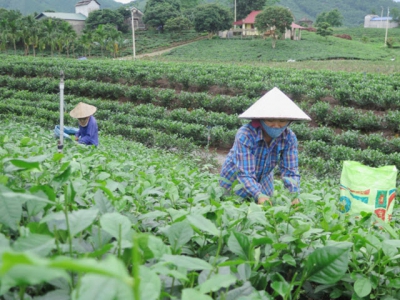Adopting novel, unique, and highly effective tea models

With the destruction of numerous traditional tea gardens for acacia production, the Tan Cuong tea area has seen the emergence of various new tea planting models with distinctive products.
Today, high-yielding tea varieties have completely replaced ancient tea varieties in Tan Cuong tea land. Photo: DVT.
Reminiscences of Guoc village's spring tea festival
For over a century, tea from the Tan Cuong district (Thai Nguyen city) has been renowned both locally and internationally for its unique delectable flavor. With a total area of about 2,000 hectares, the value of Tan Cuong specialty tea might exceed half a billion VND per hectare due to the synchronized application of solutions. Not only have tea trees aided Tan Cuong tea growers in becoming wealthy, but they have also contributed directly to the growth of Vietnam's tea business.
Guoc village is an old area situated at the foot of Guoc mountain in Tan Cuong commune. The village is the birthplace of Tan Cuong tea and the Thai Nguyen tea culture festival, which began in the late 1910s when Mr. Vu Van Hiet, also known as Mr. Doi Nam (Hung Yen province), brought the region's first tea variety to plant and established a tea plantation, as well as a tea processing workshop. "Canh Hac" tea brand was well-known across the nation and sold to other countries like France, India, and China, and was termed "Thai Nguyen's first renowned tea."
The first spring tea festival in Guoc village, as well as the first tea festival in Thai Nguyen, was held in 2004, in connection with the Spring Festival, and included traditional tea profession activities such as delicious tea contest and tea brewing contest among others.
The spring tea festival in Guoc village was celebrated yearly for the following several years. In 2005, the event's scope was extended to include areas outside of Tan Cuong commune.
In 2006, the event was renamed "Tan Cuong Spring Tea Festival" and was hosted by Guoc village. Thai Nguyen province conducted the inaugural Thai Nguyen Tea Culture Festival in 2007. The event drew almost one hundred participants from tea villages, metropolitan areas around the province, and local and international enterprises.
As a result of the spring tea festival in Guoc village, the province has organized numerous Thai Nguyen International Tea Festivals, providing opportunities to promote investment, trade, and tourism, as well as the image of the land and people, of Thai Nguyen tea, and Vietnamese tea with international friends.
Indeed, the Thai Nguyen tea brand has risen to prominence as a result of these events. The stele in Guoc village states, "Here is buried the tale of Tan Cuong's first renowned tea and the Thai Nguyen Tea Cultural Festival, Vietnam."
Ancient tea's extinction
Mr. Nguyen Duy Tien, 70, a representative of Nam Son hamlet, said that the region continued to grow antique tea trees until they were carried to tea festivals and marketed as ornamental plants in early 2000. As a consequence, those old tea plants perished in Tan Cuong tea's native homeland.
In recent years, many tea-growing families in neighboring Tan Cuong villages have spent meticulously in producing high-quality tea while also creating a brand, relegating Nam Son tea to second place due to growers' lack of concern.
At the moment, the price of midland dried bud tea in Tan Cuong's "profitable" villages has risen to over VND 1 million per kg; bud tea typically costs more than VND 250,000 per kg, while the finest midland tea in Nam Son sells for less than VND 150,000 per kg.
Tien lamented: "Only a few families in the community continue to roast tea; the others sell fresh buds at cheap costs or stop picking entirely. Previously, 100% of families produced tea, but now the number is just counted on the fingers."
Nam Son is currently covered in thick hills and forests, creating an atmosphere reminiscent of highland hilly settlements; it's hard to realize this is the location of the original Tan Cuong tea plants. Believe it or not, this terrain has been associated with tea bushes for over a century, since it is part of a world-renowned tea district in both the nation and the globe.
Related news
 Rice farming without synthetic fertilizers, higher economic efficiency
Rice farming without synthetic fertilizers, higher economic efficiency The model of cultivating rice without synthetic fertilizers has taken root in the Mekong Delta. Although the yield was only 3 to 4 tons per hectare the economic
 Vietnam’s litchis, longan sell at high prices overseas
Vietnam’s litchis, longan sell at high prices overseas Only when Vietnam can bring its farm produce to official distribution systems in countries will Vietnam’s national brand be well known by consumers around
 Remove the ‘golden headband’ for the research institute
Remove the ‘golden headband’ for the research institute Decree 70/2018/ND-CP on the management of scientific and technological assets using state capital is likened to a "golden headband" tightening on the heads